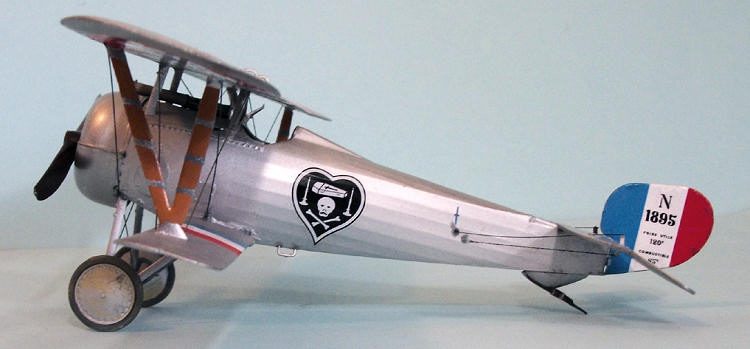
| KIT #: | 611 |
| PRICE: | $74.99 SRP |
| DECALS: | Five options |
| REVIEWER: | Tom Cleaver |
| NOTES: |

| HISTORY |
The Nieuport series of sesquiplane fighters were
designed by Gustave Delage.
The first single-seater was the Nieuport 11, known as
the Bébé for its small size - being a
single-seat development of the two-seat Nieuport 10 - first appeared as a
prototype in 1915 and became famous as one of the aircraft that ended the
“Fokker Scourge” in 1916.
The design was known as a “sesquiplane,” having a
standard two-spar upper wing, and a single-spar lower wing with less than half
the wing area of the upper wing.
This was originally developed in the Nieuport 10 to
provide the maneuverability of a biplane with the downward visibility of a
“parasol” monoplane.
The primary drawback of the design is that the lower
wing can twist under aerodynamic forces and break off unless strongly built.
Powered originally by an 80 h.p. Gnome-LeRhone rotary
and later by 110 h.p. Gnome rotaries, the Nieuport fighters were constructed as
lightly as possible to give them the performance they had with this low power.
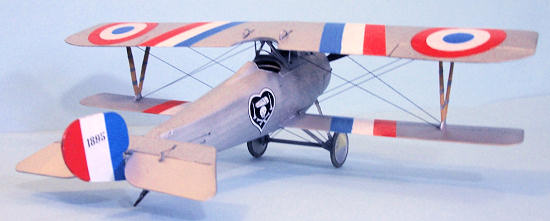 The Nieuport 11 was followed by the Nieuport 16 and then
the well-known “classic” of the type, the Nieuport 17 (all these numbers related
to the square meters of flying surface).
The Nieuport 11 was followed by the Nieuport 16 and then
the well-known “classic” of the type, the Nieuport 17 (all these numbers related
to the square meters of flying surface).
By early 1917 it was evident the Nieuport 17 was
obsolescent in comparison with the German Albatros D.
The Nieuport 23, 24, 24bis and 27 were attempts to
extend the life of the basic sesquiplane design, appearing in the last summer
and fall of 1917.
They fell far below the contemporary SPAD
Charles Nungesser:
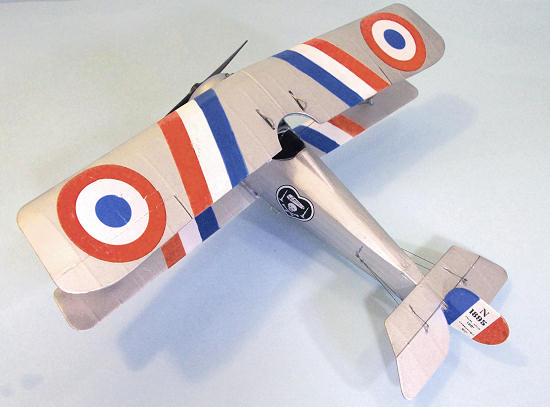 One of the most prominent pilots of the First World War,
Charles Nungesser was the epitome of the French warrior-adventurer, and was the
third-ranked French ace after Fonck and Guynemer.
One of the most prominent pilots of the First World War,
Charles Nungesser was the epitome of the French warrior-adventurer, and was the
third-ranked French ace after Fonck and Guynemer.
Born
At the outbreak of the Great War, Nungesser returned to
Flying a Voisin with Escadrille
VB106, he shot down his first German plane on
In November 1915 he was assigned to
Escadrille N65.
Shortly thereafter he met the Americans of the
Escadrille Lafayette and joined them whenever
possible, finding them similar spirits.
Recuperating from wounds again, he borrowed one of their
planes, went out and scored his third victory, for which he was made a
Chevalier de la Legion d’Honneur.
By March 1916 he was an ace, and had a score of 21 by
the end of 1916.
By the summer of 1916 he had created his own insignia: a black
heart with a coffin flanked by funerary candles, above a skull and crossbones,
which he carried on his Nieuport 17, number N1895; he would keep the rudder from
this, his “lucky” Nieuport on all other aircraft of the type he flew.
(His definition of “luck” was that when he crashed this
airplane he was so badly injured he was first thought dead, and later told he
would never fly again, though he was back in the air within two months with his
mechanic helping him into the cockpit.)
Nungesser became renowned for being both a leading ace
and an irrepressible bon vivant who would not follow the rules.
Wounded several times and injured in crashes, Nungesser
repeatedly returned to flying and was frequently placed under arrest for doing
so.
The authorities could not keep him down, since nearly every time he was
arrested it was following another victory over le Boche.
He was lionized by the press and the people of Paris.
With his rugged good looks and flamboyant personality,
combined with an appetite for danger, beautiful women, wine and fast cars, he
was the living embodiment of the mythological flying ace.
Unlike the
unsocial René Fonck, Nungesser was popular with his
fellow pilots.
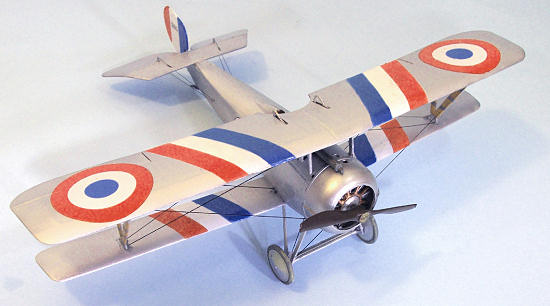 Nungesser continued to fly the Nieuport sesquiplanes,
even as they became progressively obsolescent throughout 1917 and early 1918,
moving from the Nieuport 17 to a Nieuport 24bis, a Nieuport 24 and finally a
special Nieuport 25 with a larger, more powerful engine.
By May 1918 he had 35 victories and became an
Officier de la Legion d’Honneur.
In June and July he only scored three victories and
finally bowed to the realities of air combat in August, changing to the SPAD
XIII.
On August 14, he exploded four observation balloons for victories 39
through 42. The next day he shared a victory with Marcel Henriot and another
pilot and finished the war with 43 official victories, behind René Fonck and
Georges Guynemer.
Nungesser continued to fly the Nieuport sesquiplanes,
even as they became progressively obsolescent throughout 1917 and early 1918,
moving from the Nieuport 17 to a Nieuport 24bis, a Nieuport 24 and finally a
special Nieuport 25 with a larger, more powerful engine.
By May 1918 he had 35 victories and became an
Officier de la Legion d’Honneur.
In June and July he only scored three victories and
finally bowed to the realities of air combat in August, changing to the SPAD
XIII.
On August 14, he exploded four observation balloons for victories 39
through 42. The next day he shared a victory with Marcel Henriot and another
pilot and finished the war with 43 official victories, behind René Fonck and
Georges Guynemer.
At the end of the war, the official summary of his
wounds and injuries read:
"Skull fracture, brain concussion, internal injuries
(multiple), five fractures of the upper jaw, two fractures of lower jaw, piece
of anti‑aircraft shrapnel imbedded in right arm, dislocation of knees (left and
right), re‑dislocation of left knee, bullet wound in mouth, bullet wound in ear,
atrophy of tendons in left leg, atrophy of muscles in calf, dislocated clavicle,
dislocated wrist, dislocated right ankle, loss of teeth, contusions too numerous
to mention."
After the war, Nungesser continued flying, with
difficulty.
An attempt to start a flying school ended due to lack of
students, and he caused an international incident in Cuba in 1923 when he
brought several SPAD fighters into the country and attempted to get the Cuban
Army to buy them and 40 more from him.
In 1926 he came to the United States for a series of air
shows across the country in which he flew a Hanriot H.D.1 fighter.
He left the airplane behind at Los Angeles’ Mines Field
after flying in the motion picture “The Dawn Patrol.”
Nungesser joined his wartime comrade, navigator Francois
Coli, after Coli’s partner the French ace Paul Tarascon was forced to drop out
of a proposed trans-Atlantic attempt to win the Orteig Prize, flying from Paris
to New York, the most difficult choice given the prevailing winds in the
northern hemisphere. On May 8, 1927, flying a specially-modified Levasseur PL 8,
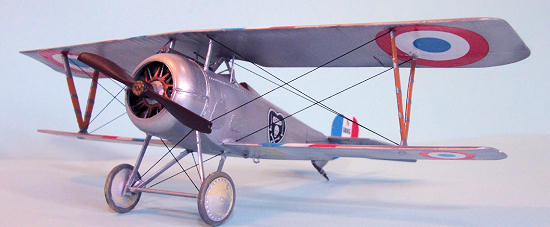 “L’Oiseau
Blanc” (“The White Bird”), Nungesser and Coli left Paris
for New York.
They were last seen passing Ireland, and were thought to have
gone down in a storm over the Atlantic.
In the 1990s, what may be the remains of the engine from
“L’Oiseau Blanc” were found in the
northern woods of Maine where they may have crashed in a storm after
successfully crossing the Atlantic.
“L’Oiseau
Blanc” (“The White Bird”), Nungesser and Coli left Paris
for New York.
They were last seen passing Ireland, and were thought to have
gone down in a storm over the Atlantic.
In the 1990s, what may be the remains of the engine from
“L’Oiseau Blanc” were found in the
northern woods of Maine where they may have crashed in a storm after
successfully crossing the Atlantic.
Two weeks after the disappearance of Nungesser and Coli,
Charles Lindbergh flew from New York to Paris in the Spirit of St. Louis.
The more difficult east-west crossing was first made
April 12–13, 1928, when Gunther von Huenfeld and Captain Hermann Köhl of Germany
and Commander James Fitzmaurice of Ireland flew the Junkers W33 “Bremen” 2,070
statute miles from Baldonnell near Dublin, Ireland to Labrador, in 36.5 hours.
It would not be until September 1–2, 1930, that
Dieudonne Costes and Maurice Bellonte successfully flew the Breguet 19 Super
Bidon “Point d'Interrogation” (“Question Mark”)from Paris to New York City.
The Hanriot H.D.1 that Nungesser flew on his 1926
American tour is today displayed with his singular insignia at The Air Museum,
Planes of Fame, in Chino, California.
You can see this airplane, with Nungesser flying it, in
the 1930 version of “The Dawn Patrol,” which was finally finished and released
four years after the flying sequences had originally been filmed.
| THE KIT |
Scott gave a full review of the kit here.
| CONSTRUCTION |
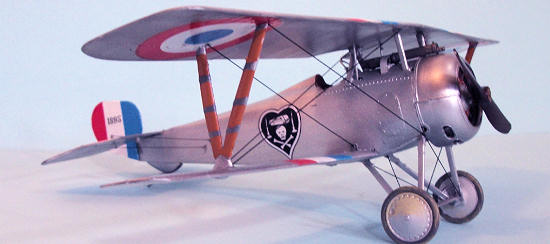 This kit presents problems due to the fact it is scaled
up from the 1/72 kit, with all the problems that kit had and some new ones.
This kit presents problems due to the fact it is scaled
up from the 1/72 kit, with all the problems that kit had and some new ones.
The cockpit area is well-detailed, but given the
limited-run aspect of the kit, there is lots of test-fitting necessary before
gluing the parts.
I limited my efforts to those items which would be seen
when the fuselage was glued together and one could only look in the open
cockpit.
After gluing the lower wings in position, I made the
horrible discovery that the two wings are not the same dimension!
Not knowing which was which, I ended up assembling the
upper wing after gluing the cabane struts in position.
I then tacked the interplane “V” struts in their proper
position on the upper wing, then took each lower wing and “eyeball measured”
them to fit. Neither was actually right, and I ended up cutting differing
amounts off the inboard tips and then shaping that area to fit the fuselage.
| COLORS & MARKINGS |
I then painted the French tricolor stripes on the upper
and lower wings using Tamiya paints.
I decided to use the very nice Academy decals from the
very bad Hobbycraft Nieuport 17 kit, which had Nungesser’s markings, since he
had flown a Nieuport 24 for about a month in the fall of 1917.
I used the Roden decals for the French cocardes and the
rudder stripes.
I realized I had to cut the “V” struts loose from the upper wing
so I could apply the underwing insignia.
| FINAL CONSTRUCTION |
| CONCLUSIONS |
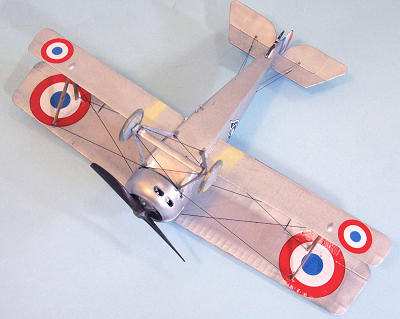
If you would like your product reviewed fairly and fairly quickly, please contact the editor or see other details in the Note to Contributors.